When and how was the Naval Aviation of Russia really born?
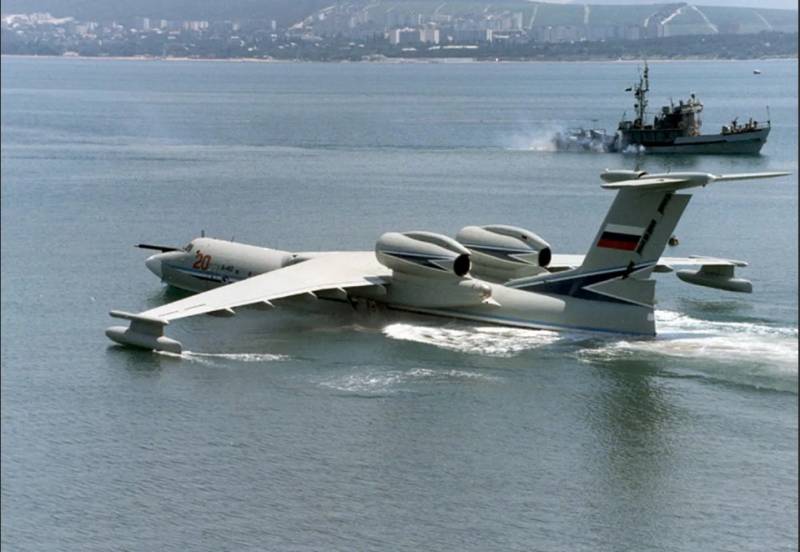
Truly, we live in peculiar times, dear readers. On the one hand, we have just an ocean of information, on the other hand, there is no swimming in it. I went in, pobbled at the bank, and back. I'm not talking about the reader yet, I'm talking about the writers. Hooked, you know.
It all started a month ago, on the Day of the Sea aviation.
Firstly, I was surprised by the tracing paper simplified to the maximum on all channels and the media: on this day, four hydroplanes, entered into battle with four German aircraft, won. Dot. And this day became the birthday of military naval aviation.
Probably, people were sitting in these seaplanes? And, perhaps, story kept their names? Might be worth mentioning?
No, it wasn't worth it. This is probably a lot in terms of information. Seaplanes took off, won. In our time - well, more than enough.
And everyone drove such a chewing gum. Without the slightest exception, the only stunning detail is the name of hydro-air transport. "Eagle". Everything else is from the evil one.
Secondly. It confuses me, yes, I am very confused by the fact that despite the Order of the Commander-in-Chief of the Russian Navy No. 253 of July 15, 1996 "On the introduction of annual holidays and professional days in the specialty", for almost 20 years we have been celebrating the day together with naval pilots their professional holiday… on the wrong date!
It is clear, of course, that it is not in our power to interrupt the Order of the Commander-in-Chief of the Navy (it was Admiral Vladimir Ivanovich Korolev, if anything), so naval pilots will still celebrate their professional holiday on a day that has nothing to do with them. Alas.
But we can restore historical justice on our pages. And at the same time remember all (or almost all) involved in these events.
This is our story, isn't it?

Therefore, we will now go beyond our usual wretched history, in which there is no place left for seaplane pilots, or descriptions of battles, or even correct dates. And let's try to fix everything "in an adult way."
So, as usual, we go to history. At the very beginning of the 20th century.
And we will start not with the battle, which did not take place on July 17, but with completely different events. Moreover, I am really grateful for this piece of history of our Russian Orthodox Church, which has kept in its archives some information that could confirm the truth of what is happening. They have an order there with reporting, so if there was some big event, there must have been a prayer service. Well, if there was a prayer service, then there is information in connection with what. Here are the confirmations...
Date one. October 1909.
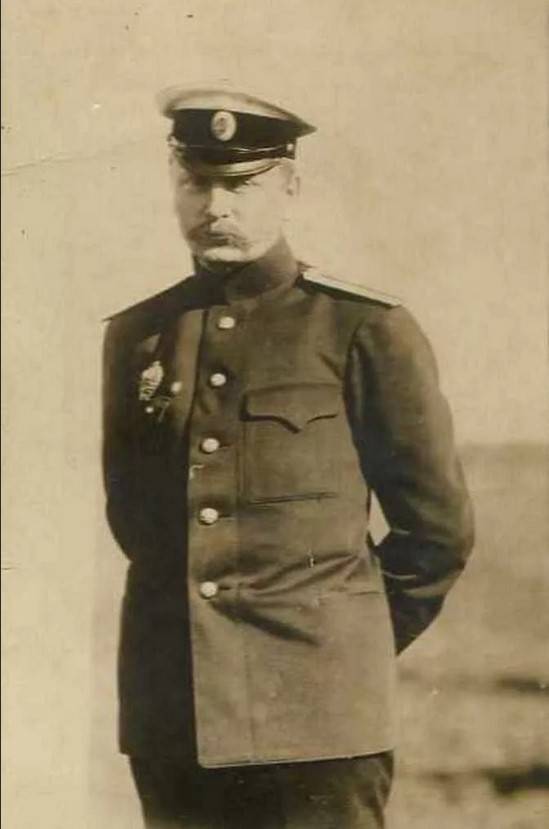
Naval officer Lev Makarovich Matsievich submits to the Chief of the Naval General Staff, Rear Admiral Andrey Eberhard, a memorandum with the necessary technical calculations, which contained a technical justification for the construction of an aircraft carrier. A ship converted from a cruiser with a light hinged deck capable of carrying up to 25 airplanes.
Date second. February 6, 1910 In St. Petersburg, the Department of Air fleet (OFE), responsible for the management of the Russian air forces. Almost at the same time, the formation of naval aviation began.
Date three. September 16, 1910

Lieutenant Stanislav Dorozhinsky, who led the aeronautic team of the Black Sea Fleet, flew from the Sevastopol airfield Kulikovo Pole on a French Antoinette-4 aircraft. This was the first flight in the history of the Russian naval air force, from which it would be worth starting the countdown of the history of Russian naval aviation.
Date four. November 11, 1910. In Sevastopol, an officer school of the air fleet department was opened, the council of which was headed by a naval officer, Captain 2nd Rank V.N. Kedrin. The school, despite its name, did not train flight personnel. But the officers of the school did a great research and analytical work to study the possibilities of naval aviation, as such.
Date fifth. May 4, 1912.

Vice-Admiral Alexander Liven, Chief of the Naval General Staff, presents a report on the creation of aviation detachments in the fleets and some results of the work of these detachments. The report is accepted with understanding and approved by Vice-Admiral I. K. Grigorovich, Minister of the Navy. Moreover, Lieven's report was published in the form of an order by the Naval Ministry.
Date six. June 2, 1912. On this day, the Chief of the Naval General Staff, Vice Admiral Alexander Lieven, issued an order to form the necessary infrastructure of aviation units in the fleet by 1913.
Two months later, on August 2, 6, the clergy of St. Andrew's Cathedral on Vasilyevsky Island served a solemn prayer service on the occasion of the launch of the first hydroplane as part of the work of the so-called Experimental Aviation Station.
The experimental aviation station can safely be called the first official aviation unit of the Baltic Fleet. The naval aviation forces of the Baltic Fleet were simply meager: one seaplane and two land planes. As part of the Black Sea Fleet, the local detachment had five hydroplanes!
Nevertheless, the service, the essence of which was mainly to collect information about the possibility of using seaplanes in the Baltic, began. In fact, you just had to take off from the water, fly and land on the water. Throw bombs and shoot machine guns. Rescue sailors from the water and so on.
Date seven. May 18, 1915.
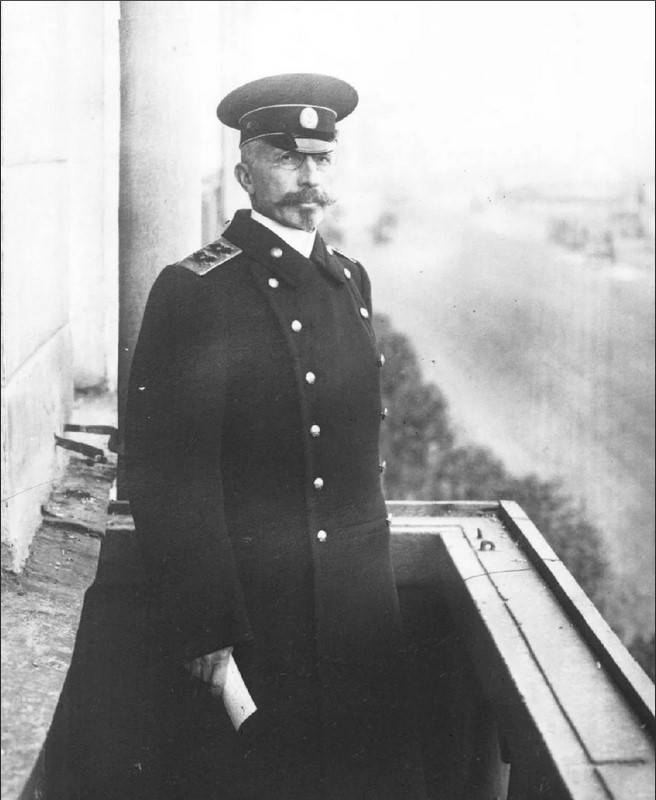
The new chief of the Naval General Staff, Vice-Admiral Alexander Rusin (Lieven died suddenly of a stroke), by his order created the St. Petersburg Naval Aviation Officer School. On July 28, in the presence of the chief, Grand Duke Alexander Mikhailovich, a solemn prayer service was served on the occasion of the opening of the school.
In general, the role of the uncle of the last Russian emperor, the grandson of Nicholas I, Alexander Mikhailovich Romanov, in the development of Russian naval aviation can only be underestimated.
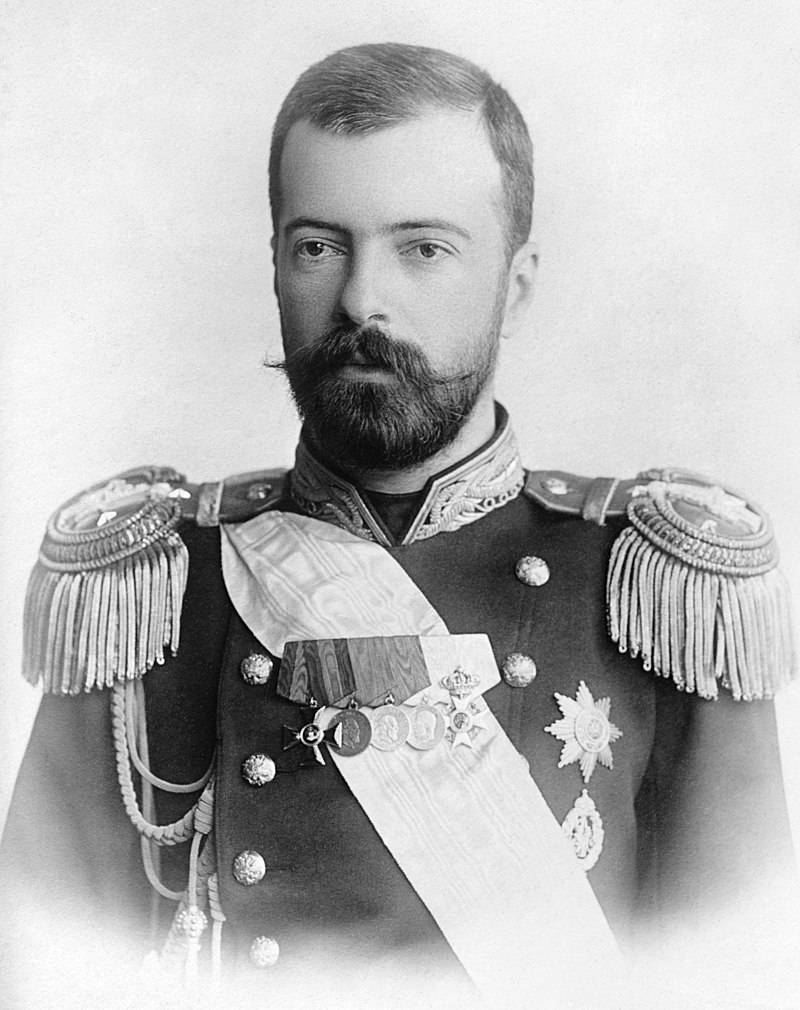
This smartest and most competent naval officer really did so much for aviation in general and naval aviation in particular that he deserves to have his name forever left in the history of Russian aviation.
In the same 1915, in the autumn, in order to "not get in the way" of the Black Sea naval pilots, the Caspian branch of the St. Petersburg officer school of naval aviation was opened in Baku on November 22.
And within the walls of the Baku branch, all four participants in the very battle received a ticket to heaven, from which, according to the Order of the Commander-in-Chief of the Russian Navy, Russian naval aviation began.
Date eight. July 4, 1916.
And what kind of date is this? And this, you know, is the date of that very battle. It happened a little earlier than indicated in all modern creations on this topic. Apparently, when the text of the Order of the Civil Code of the Russian Navy was being prepared, the one who wrote it decided that the date was in the old style and added the missing days!
In fact, the battle of naval pilots from the air wing of the Orlitsa hydro-air transport took place on July 4 (June 21, old style) 1916. This is reliably known, since one of the participants in this battle was presented for an award with the preparation of all the necessary documents for this.
We'll start with the ship.
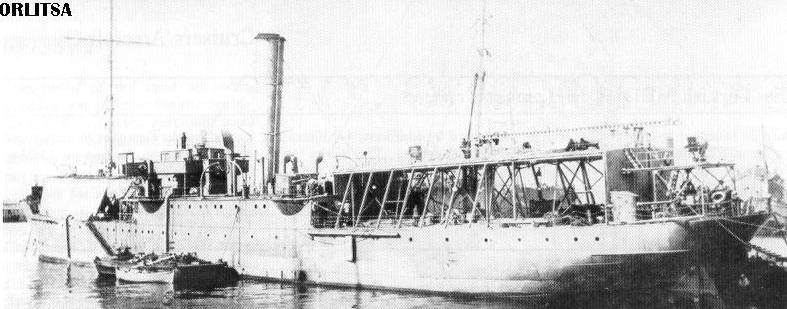
It was a passenger-and-freight ship with a displacement of only 3 tons. The maximum speed is 800 knots, and the cruising speed is 12. And at this speed, the ship could travel up to 9 nautical miles, which it did before the First World War on the St. Petersburg-London line. It was built in the UK in 5 and under the name "Vologda" he began his work. Subsequently, one of the companies that bought the ship, renamed it "Empress Alexandra".
With the outbreak of the First World War, it was decided to convert the ship into hydro-air transport or, as they said then, into an aircraft carrier.
At the Putilov shipyards, the steamer was reequipped, electric winches and Temperley booms were installed for lifting and lowering seaplanes. On the deck, permanent hangars were installed with canvas body kits instead of doors. A net was stretched over two compartments, the engine room and the boiler room, to protect the deck of the ship from enemy air bombs. Artillery armament appeared from 8 75-mm guns and two Maxim machine guns. The aviation group consisted of four hydroplanes in the hangars and one, disassembled, in the hold.
Seaplanes for the first time were French FBA, which later replaced the flying boats of Dmitry Grigorovich M-9.
The ship, new for its intended purpose, received the name "Orlitsa", under which it performed many glorious deeds, participating in wartime events in the Baltic. After the change of the ruling regime and the end of the war, "Orlitsa" was renamed "Soviet", disarmed, and in June 1918 the steamer began work as a passenger-and-freight ship in the Baltic.
In 1930, the "Soviet" was transferred to the disposal of the Far Eastern Shipping Company, where the steamer worked on the lines Vladivostok - Kamchatka and Vladivostok - Northern Sakhalin. During the rescue of the crew of the Chelyuskin steamer in 1934, in difficult ice conditions, the "Soviet" made an urgent trip to the shores of Chukotka, delivering the equipment necessary for aviation operations. During the conflict near Lake Khasan in 1938, he transported troops from Vladivostok to the combat area.
The service of the first Baltic aircraft carrier ended in 1964, when the ship was dismantled for metal.
Seaplanes

As mentioned above, at first the crews of the Russian squadron on Orlitsa flew on French technology. These were hydroplanes of the Franco-British Aviation Company (FBA). Russia bought 30 type C machines with a Gnom-Monosupap engine (100 hp), another 34 were built at the Lebedev plant.
The aircraft developed a speed of up to 105 km / h and was distinguished by very good control and seaworthiness. French (and not only) seaplane pilots "FBA" were very worthy opponents of German submariners, who drank a lot of blood.
But after 1915, Russian pilots gradually began to transfer to the domestic flying boat Grigorovich M-9.
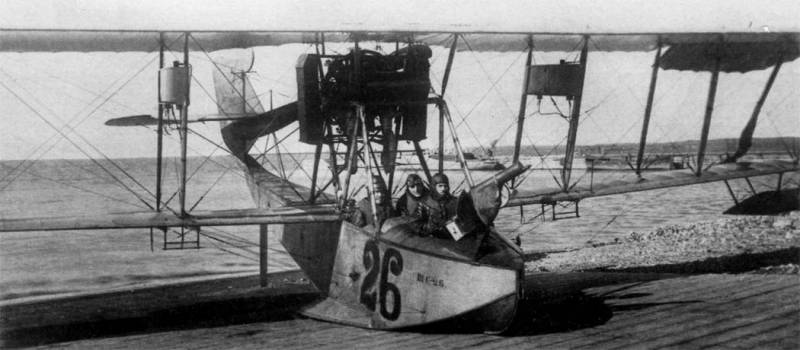
The M-9 was equipped with a French Salmson engine with a power of 150 hp, which accelerated the car to a speed of 110 km / h. Service ceiling 3 meters, flight duration up to 000 hours.
The M-9 was usually armed with one machine gun on a tripod in front of the cockpit and bombs (up to 160 kg) that were hung under the lower wing. The crew consisted of two or three people. M-9 was built in a series of more than 500 devices, which made the boat the most massive Russian seaplane of that time.
The enemy of the M-9 in that battle was the German seaplane Friedrichshafen FF.33.

A very good aircraft, most likely a modification of the FF.33I. It was an aircraft with a reduced airframe size, a 150 hp Benz Bz.III engine. and improved flight performance. The maximum speed of FF.33I is 149 km/h, cruising is about 120 km/h. Flight duration up to 6 hours. Ceiling 2 meters. The armament of the aircraft consisted of 500-1 machine guns of 2 mm caliber. A total of 7,92 aircraft were produced.
And there was another participant in this battle.
Flying boat "Hansa-Brandenburg" FB, designed by a young but promising German engineer Ernst Heinkel.

The boat was equipped with an Austro-Daimler 165 hp engine, which allowed the boat to accelerate to 140 km / h and ensured a flight duration of up to 8 hours. The Hansa-Brandenburg FB was armed with one machine gun, but could take up to 200 kg of bombs, which made the boat quite a decent strike aircraft at that time.
airmen
The entire flight crew of Orlitsa took part in that air battle. That is, all four crews.
Pilot Lt.S.A. Petrov / shooter non-commissioned officer N.P. Korshunov
Pilot Lieutenant A.N. Izvekov / shooter non-commissioned officer A.V. Nazarov
Pilot midshipman G.G. Kartsov/shooter mechanic S.A. Yarantsev
Pilot midshipman B.A. Shchepotiev / gunner non-commissioned officer A.A. Shepelev.
Let no one be embarrassed by such a set of ranks, at that time people did not come from anywhere in aviation. Our four are graduates of the Baku branch. From one issue, they received the title of naval pilots in the winter of 1916 and were sent to serve on the first Russian aircraft carrier.
In general, to be absolutely precise, the Orlitsa received its baptism of fire two days earlier. That is, July 2, 1916, according to the new style. According to reports, it was on this day that Lieutenant Sergei Petrov flew out to intercept two German aircraft that were intended to attack the battleship Slava, which was shelling German batteries on the shores of the Gulf of Riga.
In general, of course, the bombs of that time for an armored mastodon such as a squadron battleship were completely useless, on April 12, 1916, Slava already received three bombs from German seaplanes, then one sailor died.
But on July 2, Lieutenant Petrov flew out to intercept and carried it out very successfully, shooting down one German plane. The second was able to break away and escape, realizing the advantage in speed.
So the first air battle and the first victory in the Baltic took place on July 2, 1916.
And two days later, the first massive air battle took place between Russian and German seaplanes. But not 4 x 4, as our "historians" write, but still 3 against 4.
In general, this time the Germans flew specifically along the Orlitz, because they did not expect such opposition from Russian naval pilots. And having already beaten Orlitsa, one could continue to try to do something with Slava.
Therefore, 4 German aircraft flew: three Friedrichshafen FF.33 fighters and one Hansa-Brandenburg FB improvised bomber. The fighters were supposed to tie up the Russian hydroplanes in battle, and the Brandenburg from the heart to treat the Orlitsa with bombs.
This was the plan, and the Germans followed it with their proverbial precision.
But, as always, something went wrong.
Lieutenant Alexander Izvekov was on duty over the Orlitsa in loitering mode. He was the first to take the fight with three German vehicles. Three against one - not the best alignment at all times, the battle ended with the Germans shooting down Izvekov's plane. The bullets hit the gas tank, the plane caught fire and crashed into the water. The pilot, Lieutenant Izvekov, and the gunner, non-commissioned officer Nazaryev, died.
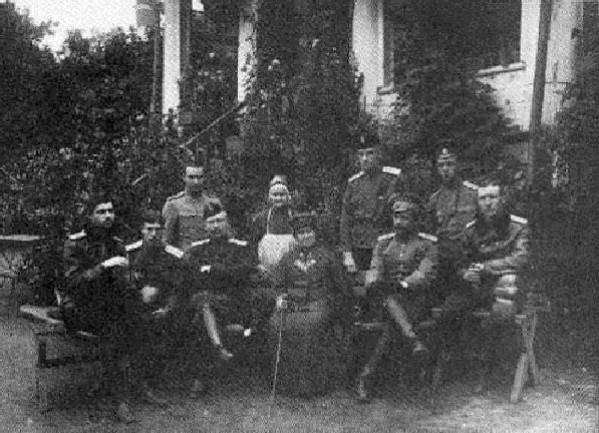
This photograph, taken in Gatchina, features Alexander Izvekov. He's on the far left
For this battle, Izvekov and Nazaryev were presented posthumously to the Order of St. George, 4th degree. And the corresponding decree was signed on August 26, 1916 according to the new style, and already from this document we can definitely establish the date when this battle took place. Not July 17th.
Izvekov and Nazaryev in their last battle were able to do the impossible - they made it possible for the rest of the crews to take off. It is clear here that hydro-air transport is not an aircraft carrier, and planes do not take off from decks and catapults, but from the water. Where they, of course, must first be placed. A long process, which can not be carried out very well under the bullets of flying enemy aircraft.
However, three of our hydroplanes took off and the battle went in a slightly different direction.
There is no information about how the Hansa-Brandenburg FB crew bombed, but this suggests that they bombed very so-so, if at all they threw bombs at Orlitsa. But one crew of three Friedrichshafen FF.33s under the luxurious number 666 was not lucky: it was shot down by the same Lieutenant Petrov.
The Germans were pursued (and even then not for long) only by midshipman Kartsov's plane, because all three German vehicles, pretty perforated, were able to go back. And two Russian seaplanes splashed down and saved the crew of a German seaplane. So Lieutenant Sieburg and Sergeant Mayer survived, but the war ended for them.
The hydroplane itself, which had capoted and turned over during landing, was not lifted: the sailors from the destroyer Okhotnik removed the machine gun and instruments from it, after which the plane was sunk by gunshots.
So the fight on July 4, which is now called the victory of July 17 in the media, is somehow not very such. The account for the lost seaplanes is 1:1, the Russian crew of the downed boat died, unlike the German one. Yes, the Germans did not fulfill their main task, but as a victorious one, Petrov's battle two days earlier looked preferable.
However, why be surprised? In such times, you know, we live ...
Probably, in order to finally close the story, it would be nice to talk about the path that fell to the lot of each of the survivors of this battle.
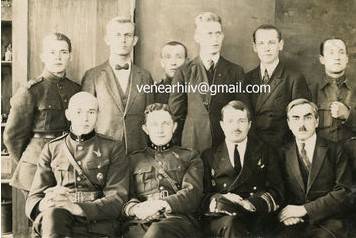
Another photo from the Baku Aviation School. In the bottom row, second from left - Kartsov, third - Shchepotiev
Sergei Petrov rose to the rank of senior lieutenant, became an ace. By the end of the war, he had already shot down 6 enemy aircraft on his account. For the battle on July 4, he was awarded the Order of St. George 4th degree, for other merits he was awarded the orders of St. Stanislav 3rd degree and St. Anna 3rd degree.
He ended the war as the commander of a separate naval aviation detachment of the air division of the Baltic Fleet. After the war, he was assigned to Baku, to the very school of naval aviation that he graduated from. Only now as head of school. And there, in Baku, at the end of February 1918, in an absolutely stupid situation, he was shot dead by a patrol of his own school, who did not recognize the head. It was very restless in Baku, so they fired aimlessly.
Midshipman Gennady Kartsov became a lieutenant. After the revolution of 1917, he went over to the side of the Reds and became a Red military pilot. But something went wrong, and in 1921 Kartsov became one of the participants in the Kronstadt uprising against the Soviet regime. After the uprising was suppressed on April 20, 1921, he was shot as a rebel on an absolutely stupid charge.
Naval pilot, Lieutenant Kartsov G.G. rehabilitated in 1994.
Midshipman Boris Shchepotiev.
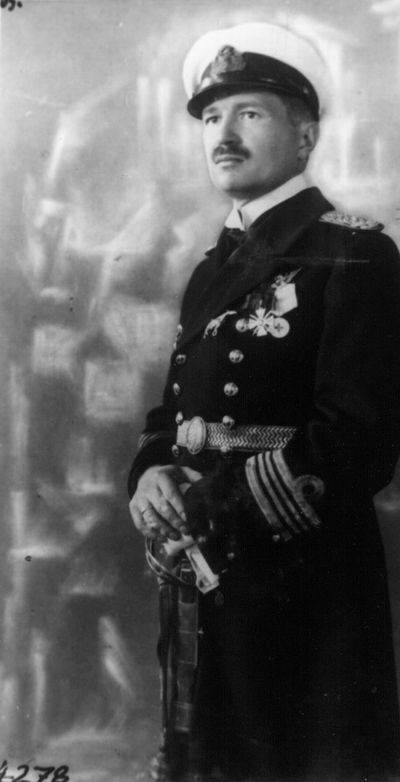
The only one who survived both world wars. Fate pretty much shook the midshipman, who, let's say right away, also rose to the rank of lieutenant, but in a slightly different way.
After the revolution, Shchepotiev ended up in the Red Army, as a military specialist. In 1918-1919 he commanded the 2nd naval fighter squadron "Iskra" on the Northern Front, and from August 1919 he served as a pilot of the 3rd squadron on the North-Western Front.
How it happened is not entirely clear, but it was from his squadron that Shchepotiev flew to the enemy during the mission and continued to fly there, but already on the side of the White Army. And there the midshipman became a lieutenant.
After the defeat of the White Shchepotiev, in an incomprehensible way, he ended up in Estonia, where he entered the service in the naval aviation of the Estonian Navy. He rose to the rank of captain-major (captain of the 3rd rank), but after the annexation of Estonia to the Soviet Union, he retired.
On June 26, 1941, they came for Shchepotiev. He was arrested and convicted. Considering that the war was already underway, everything could have been more tragic, but the court sentenced Shchepotyev to 10 years in prison. He served a cap or three of his term in Nyroblag, Perm Region. Served everything, all ten years. He did not ask to go to the front, after the end of his term he settled there, in the village of Nyrob, where he lived until his death in early 1964.
Here is such a story. A little so different from what is now being told on TV and in some of the media. Yes, it can be said that one can close one's eyes to inaccuracies in dates, and the reason for noting is not very obvious, and the story itself is not just varnished - rather, it was formatted in full, but what can we do, we live in such times.
These were the people, this is how they flew and fought. Everything that could be told about them in a hundred years is all on our pages. There is nothing more to add to the story itself, except for my gratitude to my readers who introduced me to the Our Baku website, from where, in fact, a lot of information and photographs of the battle participants were taken.
Information